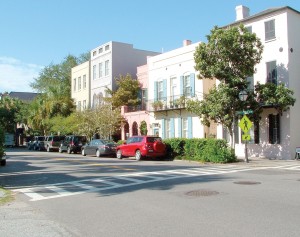
Pastel Chic –
One of America’s more colorful neighborhoods, 79-107 E. Bay St., Charleston. (Photo/Robert Clark)
Drive 144 miles to Charleston. Wind your way to East Bay Street and proceed to 79 to 107 East Bay Street. There you’ll find Rainbow Row, the colorful and historic name for 13 colorful houses. North of Tradd Street and south of Elliot Street, that’s where you’ll find them. As you’ll see, the pastel paints make it easy to see how this section of historic homes got its name. An extremely popular tourist attraction, it’s one of Charleston’s more photogenic features.
What would become Rainbow Row came to bet in the mid 18th century on 83-107 East Bay Street. At first it was a center of commerce on Charleston’s waterfront built to provide services to the wharfs and docks of the Port of Charleston. Merchants ran stores on the first floor and at day’s end they retired in the top floors.
After the Civil War the Rainbow Row area gained a less-than-stellar reputation as it was run down. Some would have referred to it as a slum. Things changed for the better. Today, Charleston consistently ranks as one of the most-traveled to cities in the world, and Rainbow Row does nothing to diminish that reputation.
The Row’s history is a strong one. In the 1920s, Susan Pringle Frost, the founder of the Preservation Society of Charleston, bought six of the buildings. Money was tight and she was unable to restore the homes in a timely manner. In 1931, Dorothy Haskell Porcher Legge purchased houses 99 through 101 East Bay and renovated them. She painted them a colonial Caribbean color scheme. Other owners and future owners, taking a cue from her, created the “rainbow” of pastel colors present today. The pastel colors helped keep the houses cool inside, and in time a cool name evolved.
Restored, the houses represent the very first style of Charleston homes and they were destined for cultural history as well. They were portrayed in “Porgy and Bess,” George and Ira Gerswhin’s opera based on DuBose Heyward’s novel “Porgy.” Heyward was a Charleston businessman fascinated by the Gullah culture. That interest turned him into a novelist. (Heyward’s wife, Dorothy, developed the novel into a play.) All three works deal with African American life in the fictitious Catfish Row, which, of course, was based on the early 1920’s Rainbow Row. George Gershwin worked on “Porgy and Bess” in Charleston where the nearby James Island Gullah community influenced him.
Like any well-known spot, Rainbow Row suffers myths. An old tale holds that the homes got their unique pastel colors so drunken sailors stumbling ashore could spot the houses where they had rented “landlubber” accommodations. Of course, that’s just a myth.
Go see the real deal, Rainbow Row, a colorful, historical tourist attraction that a few folks call home.
If You Go …
Rainbow Row
East Bay Street
Charleston, S.C. 29401
www.historiccharleston.org/Shop/Rainbow-Row.aspx
Learn more about Tom Poland, a Southern writer, and his work at www.tompoland.net. Email day-trip ideas to him at [email protected].











